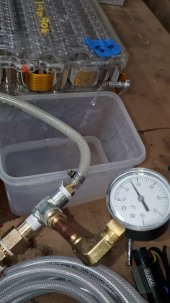GyroGypsy
New Member
- Joined
- Nov 22, 2019
- Messages
- 29
My DIY RV system has used two Tesla S batteries for over two years with no issue. I am using a thermostat controlled aquarium fluid heater and DC pump to maintain at least 60 degrees F while using the internal battery thermistors for monitoring. This was initially tested to 10 degrees F here in Colorado. A simple pinwheel indicator monitors the flow of the RV antifreeze fluid used. Self priming Pump runs 24x7 and is submerged in the fluid reservoir. It is rated at 210 gph, but I am sure the battery flow restrictions limited this.
Over the last year, I noticed the pinwheel turning slower and slower. Last winter history showed more temperature variance than previous year. When I shut down and restarted the pump, the fluid would no longer flow through the batteries. A new pump makes no difference. I can blow 15 psi air through the system, and get old fluid blown out.
I am reluctant to try any higher air or fluid pressure until I can learn the battery internal pressure rating.
Does anyone have this value, or know a possible technical source?
Please don't reply with a lecture about system redesign using heating pads or different batteries.
System write up here if interested.
Over the last year, I noticed the pinwheel turning slower and slower. Last winter history showed more temperature variance than previous year. When I shut down and restarted the pump, the fluid would no longer flow through the batteries. A new pump makes no difference. I can blow 15 psi air through the system, and get old fluid blown out.
I am reluctant to try any higher air or fluid pressure until I can learn the battery internal pressure rating.
Does anyone have this value, or know a possible technical source?
Please don't reply with a lecture about system redesign using heating pads or different batteries.
System write up here if interested.
Tesla Coach Battery Installation - Why? How? - iRV2 Forums
I am asked numerous times about my system. I performed this upgrade in spring 2000. The COVID quarantine gave me plenty of free time, and it achieved my "5 C" goals of Capacity, Cubic Inches,
www.irv2.com



